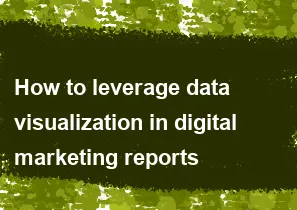How to leverage data visualization in digital marketing reports

Data visualization is a powerful tool in digital marketing reports as it helps communicate complex information in a visually appealing and easy-to-understand manner. Here are several ways to leverage data visualization effectively in your digital marketing reports:
Identify Key Metrics: Determine which key performance indicators (KPIs) are most important to your digital marketing efforts. These could include metrics like website traffic, conversion rates, click-through rates, engagement metrics, etc.
Choose the Right Visualization Types: Select appropriate visualization types that best represent your data and make it easy for your audience to interpret. Common types of visualizations include line charts, bar graphs, pie charts, scatter plots, heatmaps, and more.
Use Interactive Visualizations: Utilize interactive visualizations whenever possible to allow your audience to explore the data further. Interactive elements such as filters, tooltips, and drill-down capabilities can enhance engagement and understanding.
Tell a Story: Structure your digital marketing reports in a way that tells a cohesive story using data visualizations. Start with an overview, delve into specific metrics, and conclude with actionable insights and recommendations.
Visualize Trends Over Time: Use line charts or area graphs to visualize trends over time for key metrics like website traffic, conversion rates, and social media engagement. This helps stakeholders understand performance patterns and identify areas for improvement.
Compare Performance Across Channels: Utilize bar graphs or stacked charts to compare performance metrics across different digital marketing channels such as organic search, paid search, social media, email marketing, etc. This helps identify which channels are most effective in achieving your goals.
Highlight Key Insights with Annotations: Use annotations, labels, or callouts within your visualizations to draw attention to key insights or significant data points. This helps ensure that important findings are not overlooked.
Visualize Customer Journeys: Create visualizations that illustrate the customer journey, from initial touchpoints to conversions. This can include funnel visualizations, user flow diagrams, or heatmaps to visualize where users are dropping off or engaging the most.
Use Geospatial Visualizations: If applicable, use maps or geospatial visualizations to show the geographic distribution of website visitors, customers, or campaign performance. This can provide valuable insights for targeted marketing efforts.
Maintain Visual Consistency: Ensure visual consistency throughout your reports by using consistent color schemes, fonts, and labeling conventions. This helps maintain clarity and makes it easier for stakeholders to interpret the data.
Experiment with Data Visualization Tools: Explore various data visualization tools and platforms available (e.g., Tableau, Google Data Studio, Power BI, etc.) to find the ones that best suit your needs and allow for seamless integration with your digital marketing data sources.
Simplify Complex Data: Simplify complex datasets by breaking them down into digestible visualizations. Avoid overcrowding visualizations with too much information, and focus on presenting the most relevant insights.
By leveraging data visualization effectively in your digital marketing reports, you can enhance comprehension, facilitate data-driven decision-making, and ultimately drive better results for your marketing efforts.
-
Popular Post
- How to optimize for Google's About This Result feature for local businesses
- How to implement multi-language support in an Express.js application
- How to handle and optimize for changes in mobile search behavior
- How to handle CORS in a Node.js application
- How to use Vue.js with a UI framework (e.g., Vuetify, Element UI)
- How to configure Laravel Telescope for monitoring and profiling API requests
- How to create a command-line tool using the Commander.js library in Node.js
- How to implement code splitting in a React.js application
- How to use the AWS SDK for Node.js to interact with various AWS services
- How to use the Node.js Stream API for efficient data processing
- How to implement a cookie parser middleware in Node.js
- How to implement WebSockets for real-time communication in React
-
Latest Post
- How to implement a dynamic form with dynamic field styling based on user input in Next.js
- How to create a custom hook for handling user interactions with the browser's device motion in Next.js
- How to create a custom hook for handling user interactions with the browser's battery status in Next.js
- How to implement a dynamic form with dynamic field visibility based on user input in Next.js
- How to implement a dynamic form with real-time collaboration features in Next.js
- How to create a custom hook for handling user interactions with the browser's media devices in Next.js
- How to use the useSWRInfinite hook for paginating data with a custom loading indicator in Next.js
- How to create a custom hook for handling user interactions with the browser's network status in Next.js
- How to create a custom hook for handling user interactions with the browser's location in Next.js
- How to implement a dynamic form with multi-language support in Next.js
- How to create a custom hook for handling user interactions with the browser's ambient light sensor in Next.js
- How to use the useHover hook for creating interactive image zoom effects in Next.js